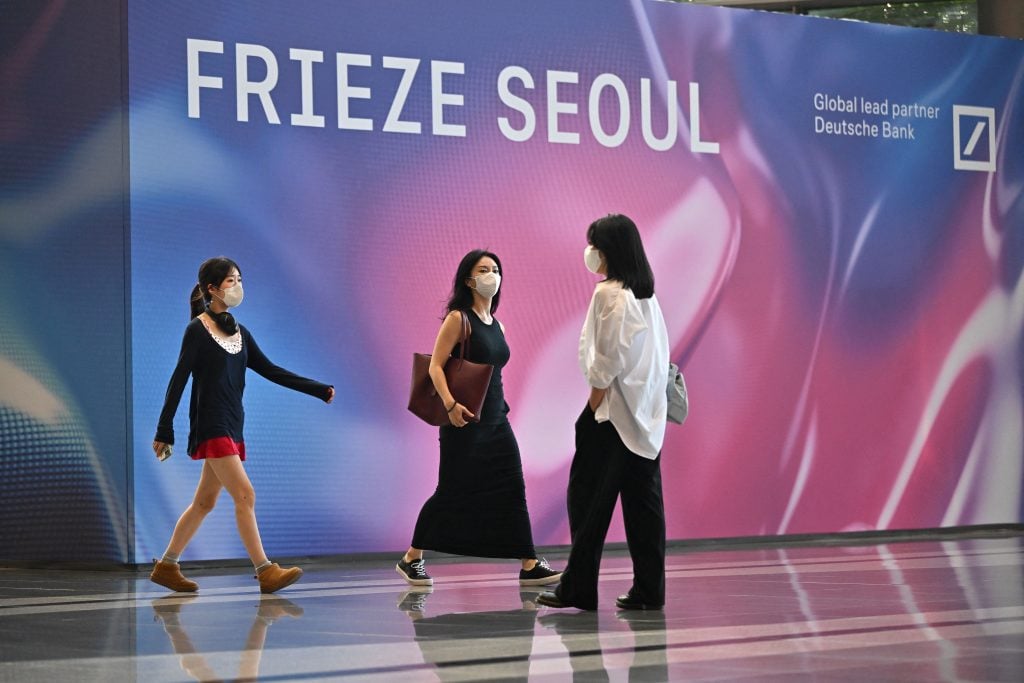Artnet News Pro
Ahead of Frieze Seoul, Three Art Lawyers Offer Hints on the Ins and Outs of Selling Art in Korea
Take our pop quiz on transacting in the Korean art market.

Take our pop quiz on transacting in the Korean art market.

Charles and Thomas Danziger &
Kate Yuhkyoung Rhie

Summer’s almost over, and as kids go back to school many of our clients and friends are heading to Asia for Frieze Seoul. We assume that you will have done your homework before boarding your flights, but just to confirm that everyone is prepared for the fair—and as a nod to Korea’s famously difficult exam culture—we are springing a pop quiz on an important topic: how to sell artwork in Korea.
The format is true or false, and if you cheat by looking at the answers below, you’re only cheating yourselves…
Question 1: Korea has a thriving economy, so its art market must be huge, right?
False. In fact, the pool of active art collectors is surprisingly small. According to Nacksoon Jang, the chairman of Gallery Bisunjae in Seoul, there were only about 1,000 collectors in 2017, and although that number had tripled by 2022, when international galleries and art fairs started coming to Korea, the newest collectors tend to see art as an investment, meaning they could easily leave the market if the economic tide turns.
Question 2: The Korean art market is focused entirely on Seoul.
False. Although the capital is the biggest player in the Korean market, collectors also hail from Busan and Daegu and are well worth researching for possible sales.
Busan is a wealthy city with any number of new collectors and an active—albeit confusing and volatile—art market. In 2022, the city’s biggest international art fair, Art Busan, reported more than $60 million dollars in sales, with many exhibitors selling out all their works. The pace of sales does seem to have slowed at Art Busan in 2023, which may be why fair organizers have so far declined to release the results.
Daegu is more conservative and the art scene more local than Seoul or Busan—think the U.S. Midwest vs. East Coast—with many galleries selling only works by artists from that city. But Daegu also has a longstanding tradition of art collecting, and its wealthy families have built substantial collections over generations. Consider using local contacts before selling in Daegu.
Question 3: Korean collectors lack good access to information on artists and artworks, so dealers can be aggressive in pricing.
False (but you knew that). This may be one of the biggest misconceptions about the Korean art market. Koreans are extremely digitally savvy, and collectors do extensive online research before buying works of any value. They also share information and seek advice via social clubs, art foundations, and gallery sponsored programs. If they like an artist’s works, you should assume they’ve studied auction results and read relevant articles in the Western press. And because the collecting community is tight-knit, a Western gallery that takes a short-sighted approach—say, by trying to overcharge—can quickly sink its reputation in Korea.
Question 4: Korean buyers require a high level of professional service and “touch” even after a sale is completed.
True. Korea has a strong culture of so-called “after service” (think Hyundai’s famous, unusually long 10-year car warranty), and galleries there typically provide more services to their clients than in the U.S. or Europe, like arranging for the hanging of works in clients’ homes. Korean galleries also create social networks around their clients, including holding lecture series and even incorporating restaurants and gyms into their galleries. This approach recalls the old Korean adage that churchgoers make the strongest troops—because they meet weekly and have shared experiences and beliefs.
Question 5: Korean collectors rely heavily on local art advisors before making purchases.
False. Unlike in the U.S. and Europe, Korea has very few seasoned art advisors, and most are quite young. As a result, collectors do their own homework.
Question 6: The Korean tax system is favorable to art buyers.
True. Korea is actually a great place to buy and sell art, with beneficial VAT and sales tax regulations and no capital gains tax on the sale of works below 60 million Korean won (approximately U.S. $55,000) regardless of the artist’s nationality. If the work is created by a Korean artist who is living when a transfer is made, no capital gain tax is imposed no matter what the price of the work.
Note that Korea’s special tax benefits are limited to unique works of art, which the taxing authority has determined does not include works created electronically. For example, last year the Korean Customs Office ruled that a work created by David Hockney on his iPad was not fine art and therefore not eligible for VAT tax benefits because the artist created and printed it through electronic means.
Question 7: Korean cultural institutions are notoriously slow in making decisions on purchases and exhibitions.
False. In fact, we have organized major exhibitions in Korea ranging from Matisse to Munch in as little as 18 months— transactions which would have taken years and years in, say, Japan.
Question 8: Korean clients routinely ask for big discounts when negotiating art purchases.
True again. Koreans enjoy negotiating, and some galleries there may typically give a 30%-50% discount off the initial asking price. Be prepared to take a sharp pencil to asking prices as the fair winds down.
Conclusion: In Korea, planes are sometimes grounded to reduce noise levels during exams. We hope this pop quiz doesn’t delay your flight home.
Thomas and Charles Danziger are partners in the New York firm Danziger, Danziger & Muro, LLP, specializing in art law, and DanzigerArt, specializing in exhibitions. Attorney Kate Yuhkyoung Rhie is of Counsel to Danziger, Danziger & Muro, LLP and is an art law research professor at Korea University.
Go to danziger.com and DanzigerArt.com for more information. Nothing in this article is intended to provide specific legal advice.